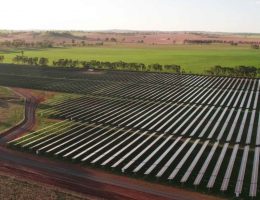The complete absence of long-term emissions reduction targets in the freshly launched Technology Investment Roadmap has seen the Morrison government criticised for lacking direction and failing to give investors the confidence they desperately need to support Australia’s energy transition.
Speaking at the National Press Club in Canberra, federal energy and emissions reduction minister Angus Taylor said that the Morrison government would set a post-2030 emissions reduction target “in a few years’ time”.
“Our focus is on our 2030 target in the Paris Agreement. That’s the nationally determined contribution. And in a few years’ time, we’ll have to extend that out to 2035. That’s how the Paris Agreement works. And we’ll continue on from there. That’s the goal. What we’re not going to do is impose a target that’s going to impose costs on the economy, destroy jobs, and stop investment,” Taylor said.
Under the Paris Agreement, countries are required to communicate 10-year emissions reduction pledges, and Australia, as a signatory, is required to set and announce a 2035 emissions reduction target before 2025.
The Morrison government appears set to wait until the last minute to communicate its target, and still refuses to commit to a goal of net-zero emissions by 2050, despite it being widely adopted by state governments and business groups.
Reacting to the Morrison government’s first Low Emissions Technology Statement under the Technology Roadmap launched by Angus Taylor on Tuesday, business and environmental groups alike said the policy was effectively meaningless without a long term emissions reduction target.
Labor’s shadow minister for climate change and energy, Mark Butler, echoed the calls for the Morrison government to adopt a 2050 emissions target.
“What Australia has desperately needed is a genuine energy policy to drive investment in affordable, reliable, clean power,” Butler said.
“Scott Morrison refuses to deliver a genuine energy policy and he still refuses to commit to net zero emissions by 2050.”
Australian Greens leader Adam Bandt said that the Morrison government’s roadmap would see Australia locked into using coal and gas, at a time when governments should be planning to phase out the use of fossil fuels.
“This roadmap will take us off a cliff,” Bandt said. “The Morrison government is accelerating towards climate collapse.
“This technology list is a fig leaf for the continued expansion of the fossil fuel industry. This roadmap contains no plan to phase out coal and gas. In fact, the roadmap bakes in coal and gas for years to come, subsidising the coal and gas cartels from the public purse.”
The Investor Group on Climate Change, which represents some of Australia’s largest institutional investors and superannuation funds, said that a commitment to net-zero emissions by 2050 would be necessary to provide investor certainty.
“The scale of investment needed to reach net-zero emissions and the natural fiscal constraints of federal budgets means engaging private capital is critical to any successful climate policy. Government investment alone cannot address the systemic risks that climate change poses to our economy,” the IGCC director for policy, Erwin Jackson, said.
“The Technology Investment Roadmap is not a substitute for a coherent national climate policy framework for the entire economy and a clear target for net-zero emissions by 2050.”
The Clean Energy Council said that the barriers remained that were slowing down the deployment of new wind and solar projects, including the need to coordinate new network infrastructure investment, and that it was disappointing to see the technology roadmap overlook these issues.
“While wind and solar are now proven technologies and attracting enormous investor support, they are also the technologies that can have the greatest impact in decarbonising Australia’s energy system and economy,” Clean Energy Council chief executive, Kane Thornton said.
“It is therefore surprising and disappointing that the roadmap fails to address the range of barriers to their accelerated deployment.”
The Australian Conservation Foundation’s climate program manager Gavan McFadzean said that the Technology Roadmap needed to include medium and long-term targets for emissions reduction.
“The goal of net-zero emissions by 2050 is backed by every state and territory government, the federal opposition and every major industry body, including the Australian Energy Council, Business Council of Australia, Australian Industry Group and National Farmers Federation, yet the Morrison government refuses to set a destination for its roadmap,” McFadzean said.
“Promoting new clean technologies can cut climate pollution, but Australia’s roadmap should be guided by science-based medium and long-term emissions targets to drive investment and track performance.”
The Smart Energy Council said that federal government energy policy, if it is to drive substantial reductions in Australia’s greenhouse gas emissions, would need to embrace zero-emissions technologies like wind and solar, rather than ignore them altogether.
“The Technology Roadmap provides no destination, no targets, no clear direction. It just takes us to a dead end,” SEC chief executive John Grimes said.
“A genuine Technology Roadmap would recognise that we urgently need to tackle the economic crisis and the climate crisis at the same time. We need to revitalise and decarbonise our economy. That means investing in renewable energy infrastructure and renewable hydrogen, creating new jobs and building new industries.”
Oxfam Australia’s chief executive, Lyn Morgain, said the technology roadmap showed that the Morrison government had not been serious about addressing climate change and that a failure to support zero-emissions technologies like wind and solar was condemning Australia to worsening impacts of global warming.
“The government’s plan to invest in technologies that use energy from fossil fuels to reduce our carbon emissions is illogical and out of step with public opinion. This roadmap condemns Australians to more extreme bushfire seasons, and threatens the very existence of our Pacific neighbours,” Morgain said.
“If the government was serious about addressing the climate crisis, it would make serious commitments to invest in zero-carbon technology like wind, solar and batteries, to reduce carbon emissions as well as power prices. Today’s technology roadmap is not the answer.”










